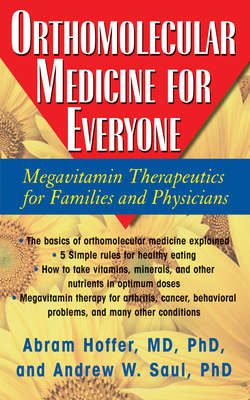Читать книгу Orthomolecular Medicine for Everyone - Abram Hoffer M.D. Ph.D. - Страница 37
На сайте Литреса книга снята с продажи.
NATURAL VERSUS SYNTHETIC
ОглавлениеPeople using vitamins have been confused by claims that natural vitamins are healthier than synthetic ones. It is important to understand what these various terms really mean. Vitamins are all organic molecules, whether made by plants or humans—they are in every way identical. The only difference is that vitamins made by plants and still present in the plant do not contain trace additives, which are present in human-made vitamins. But when plant-made vitamins are extracted and purified and made into a crystalline powder or into tablets, they also contain traces of all the chemicals used in the process. They differ from synthetic vitamins only in having different trace additives. The only way to ensure additive-free vitamins is to use food only, but this is unreasonable advice for those who require more than food can supply.
TESTS FOR DETERMINING NUTRIENT LEVELS
Laboratory tests for determining which vitamins are required and in what quantities have only been moderately helpful. The main reason is that measurable changes occur long after a very serious deficiency is present. In pellagra, a fatal disease, vitamin B3 blood levels are normal at onset and it also appears in the urine. Total nucleotides in the red blood cells are also normal. There is, however, an increased proportion of mononucleotides that may rise from 2–3 percent to around 12 percent of the total. The dinucleotide nicotinamide adenine dinucleotide (NAD) is the active antipellagra factor, while mononucleotides have no vitamin function. The ratio of mono- to dinucleotides is not measured in clinical laboratories. If one waits for definite abnormalities, one has waited too long before instituting vitamin therapy.
A second reason vitamin assays have been inefficient is that a measurement of body fluids gives only a very crude indication of the levels present within the tissues and cells. We can only guess how much vitamin C is present in the brain, the humors of the eye, or the adrenal cortex by the amount in blood or by the amount that spills into the urine. Vitamin levels in blood are not helpful in determining how much should be taken each day. Very low levels certainly are proof that a deficiency is present, but normal values do not mean that no supplements should be used. Many people with normal blood values became well after supplementation with the vitamin apparently already present in “normal” quantities.
Another way is to measure reactions that depend upon vitamins—with a deficiency, this reaction becomes abnormal. However, these reactions are not nearly sensitive enough. The deficiency must be very severe before abnormal reactions become apparent. A number of laboratory procedures (tests) are available from a few specialized laboratories to help the nutritionally oriented physician be more precise in formulating the nutrients required. They are also helpful in persuading patients that they should try the treatment program.
Until these problems are solved by finding measures that parallel the state of health, we will have to depend on clinical judgment, an awareness of the need for vitamins, and a therapeutic response to determine the optimum quantity. Fortunately, vitamins are so safe that there is hardly any danger to the person in determining the best dose. This is done by increasing the dose slowly until there is no further improvement. Once this has been achieved, the person can test which is the best continuing dose by decreasing the quantity. If he or she remains in good health, the newer dose can be used; if symptoms reappear, the dose can be increased. Each vitamin has unique properties that must be understood, since they are helpful in establishing the correct dose.
A food extract or dried preparation rich in a particular vitamin would also contain minerals, vitamins, and enzymes related to the metabolism of the vitamin, but all would be present in small amounts. For example, a dried powder made from acerola or rose hips will contain some vitamin C, plus the enzymes, minerals, and other vitamins that helped create it and help metabolize it. But for a person needing large doses of vitamin C, too much of the powder would have to be consumed.
Further confusion is generated by current labeling laws. A product may have no synthetic or extracted vitamin in it, yet the label may list a large number of vitamins. For example, yeast tablets contain very small amounts of many vitamins. They are not vitamin tablets but are really a tableted food. Rose hips powder is a relatively poor source of vitamin C and must be reinforced with a lot more to make 100-mg or stronger tablets, and therefore is a mixture of mostly synthetic and very little natural-source vitamin C. It would be better if the catch-all term natural was dropped. The label should simply indicate the source and quantity of each nutrient.
